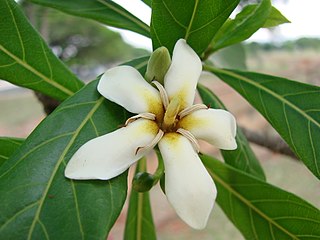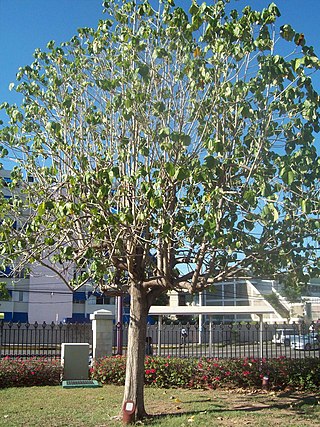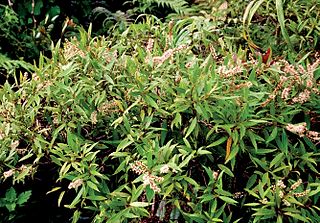
The geography of Puerto Rico consists of an archipelago located between the Caribbean Sea and the North Atlantic Ocean, east of Hispaniola, and west of the Virgin Islands and north of Venezuela. The main island of Puerto Rico is the smallest and most eastern of the Greater Antilles. With an area of 8,897 square kilometres (3,435 sq mi), it is the third largest island in the United States and the 82nd largest island in the world. Various smaller islands and cays, including Vieques, Culebra, Mona, Desecheo, and Caja de Muertos comprise the remainder of the archipelago with only Culebra and Vieques being inhabited year-round. Mona is uninhabited through large parts of the year except for employees of the Puerto Rico Department of Natural Resources.

Tropical and subtropical moist broadleaf forests (TSMF), also known as tropical moist forest, is a subtropical and tropical forest habitat type defined by the World Wide Fund for Nature.

Genipa americana is a species of trees in the family Rubiaceae. It is native to the tropical forests of North and South America, as well as the Caribbean.

Cyrilla racemiflora, the sole species in the genus Cyrilla, is a flowering plant in the family Cyrillaceae, native to warm temperate to tropical regions of the Americas, from the southeastern United States, south through the Caribbean, Mexico and Central America to northern Brazil and Venezuela in South America. Common names include swamp cyrilla, swamp titi, palo colorado, red titi, black titi, white titi, leatherwood, ironwood, he huckleberry, and myrtle.

Talipariti elatum or Hibiscus elatus, known typically as the blue mahoe or majó azul, is a species of flowering tree in the mallow family, Malvaceae.

Ulmus mexicana, the Mexican elm, is a large tree endemic to Mexico and Central America. It is most commonly found in cloud forest and the higher elevations of tropical rain forest with precipitation levels of 2–4 m (79–157 in) per year, ranging from San Luis Potosi south to Chiapas in Mexico, and from Guatemala to Panama beyond. The tree was first described botanically in 1873.

Eucalyptus robusta, commonly known as swamp mahogany or swamp messmate, is a tree native to eastern Australia. Growing in swampy or waterlogged soils, it is up to 30 m (100 ft) high with thick spongy reddish-brown bark and dark green broad leaves, which help form a dense canopy. The white to cream flowers appear in autumn and winter. The leaves are commonly eaten by insects and are a food item for the koala. It is an important autumn-winter flowering species in eastern Australia and has been planted extensively in many countries around the world. Its timber is used for firewood and in general construction.

Schoepfia arenaria is an extremely rare species of hemiparasitic flowering plant in the Schoepfiaceae family. It grows as a small, multi-trunked tree. It is endemic to Puerto Rico, where it is found growing along the northern coast. A local Spanish vernacular name recorded for this tree is araña ('spider'). It has no common name in English.

Plumeria rubra is a deciduous plant species belonging to the genus Plumeria. Originally native to Mexico, Central America, Colombia and Venezuela, it has been widely cultivated in subtropical and tropical climates worldwide and is a popular garden and park plant, as well as being used in temples and cemeteries. It grows as a spreading tree to 7–8 m (23–26 ft) high and wide, and is flushed with fragrant flowers of shades of pink, white and yellow over the summer and autumn.

Guazuma ulmifolia, commonly known as West Indian elm or bay cedar, is a medium-sized tree normally found in pastures and disturbed forests. This flowering plant from the family Malvaceae grows up to 30m in height and 30–40 cm in diameter. It is widely found in areas such as the Caribbean, South America, Central America and Mexico serving several uses that vary from its value in carpentry to its utility in medicine.

The Puerto Rican moist forests are a tropical moist broadleaf forest ecoregion in Puerto Rico. They cover an area of 7,544 km2 (2,913 sq mi).

Magnolia portoricensis is a tree of the Caribbean region. Its vernacular names include jagüilla and Puerto Rico magnolia. It is native to Puerto Rico and it is found in the Toro Negro State Forest. It is an endangered tree and endemic to Puerto Rico. It is a dicot and a part of the family Magnoliaceae. It is an uncommon tree, found primarily in the central and western mountains at 500 to 925 m above sea level.

Pterophylla fraxinea, formerly known as Weinmannia fraxinea, is a tree in the family Cunoniaceae. It grows up to 40 metres (130 ft) tall. The bark is grey to dark brown. Inflorescences bear up to three pairs of flowers. The specific epithet fraxinea is from the Latin meaning "ash tree", referring to the leaves' resemblance to those of the genus Fraxinus.

The Santa Marta montane forests (NT0159) is an ecoregion in the Sierra Nevada de Santa Marta, a massif on the Caribbean coast of northern Colombia. The ecoregion covers altitudes from near sea level up to around 3,300 metres (10,827 ft), where it gives way to Santa Marta páramo. The isolation of the massif and the range of elevations and climates has resulted in a wide variety of species including many endemics. The lower levels contained tropical rainforest, which has largely been cleared. Higher up, this gives way to cloud forest. Much of this has also been cleared for coffee plantations, pasture for sheep and cattle, and farming.

The Sierra de Luquillo is a mountain range located in the northeastern part of Puerto Rico. Also known as the Luquillo Mountains, these are steep-sided, densely-forested mountains rising to elevations of around 1,075 m (3,527 ft), the highest point being the summit of El Toro, closely followed by that of Pico El Yunque.

Brunellia comocladifolia, commonly known as the West Indian sumac, is a species of tree in the family Brunelliaceae. It is native to Central America, the West Indies, and northern South America.

Solanum pachyandrum, known as bombona, is a spine-forming vine of the Solanum genus. It is native to southwestern Ecuador and northwestern Peru where the large juicy fruit is commonly eaten and considered a treat by children. Although the plant has been known and consumed by the indigenous people of that land, it was only published scientifically in 1914 by German botanist Friedrich August Georg Bitter.
Maianthemum amoenum is a perennial flowering plant, growing as an epiphyte on trees in cloud forests from Mexico south to Honduras.
Cornus excelsa is a species of flowering plant in the dogwood genus (Cornus). It is native to mountain forests of Mexico, Guatemala, and Honduras.

Pterophylla marquesana, formerly known as Weinmannia marquesana, is a species of plant in the family Cunoniaceae. It is a shrub or tree endemic to the Marquesas Islands of French Polynesia.



















